Post by Pearl Ton, a pre-med undergraduate pursuing a Bachelor of Science in Psychology and minors in both Business Administration and Interdisciplinary Neuroscience at Portland State University.
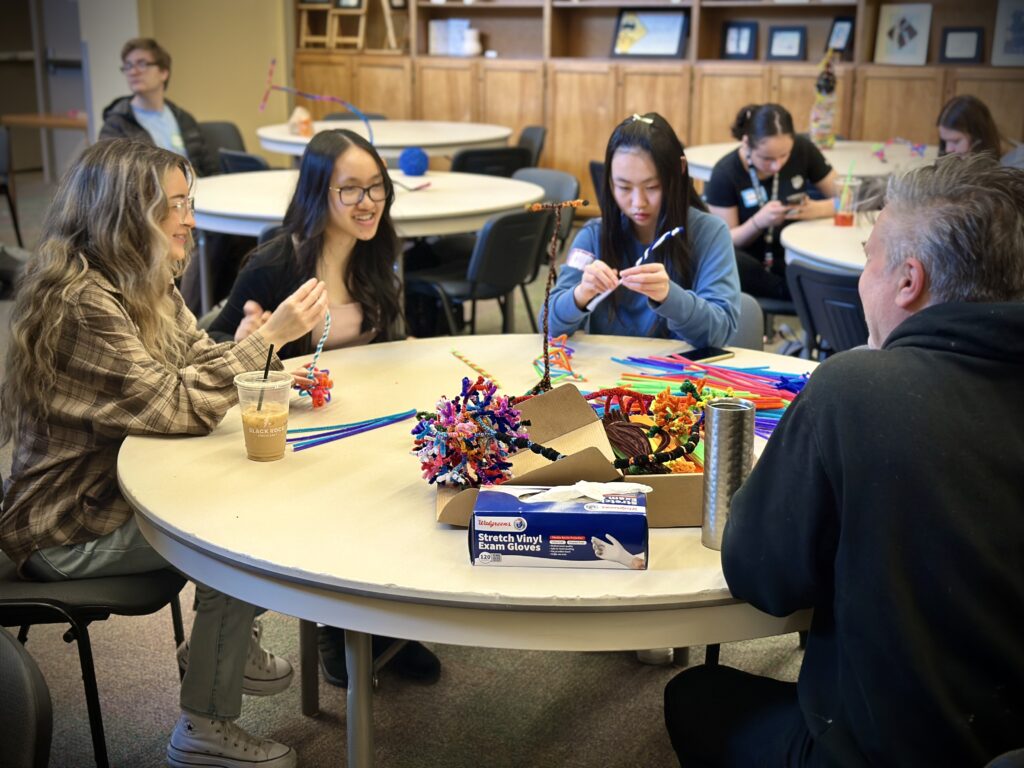
Hi there! My name is Pearl and I’m a premed student at Portland State University. My major is Psychology while my minors include Interdisciplinary Neuroscience and Business Administration. A fun-ish fact about me is that I have a merle chihuahua that I love very, very much. He is my SUNSHINE.

LEARN MORE: Brains Love Animals
LEARN MORE: The Power of Pets – Health Benefits of Human-Animal Interactions
One of the first outreach experiences I joined was at Sunnyside Environmental School in Portland Public Schools, which welcomes kids in kindergarten through 8th grade. As I walked around the school, trying to find an entrance, I couldn’t help but notice the beautiful sun and nature all around. Students were all playing outside, and there were so many plants inside the building. I wondered if popular podcaster Andrew Huberman’s constant talk about the benefits of sunlight really has the impact that he claims.
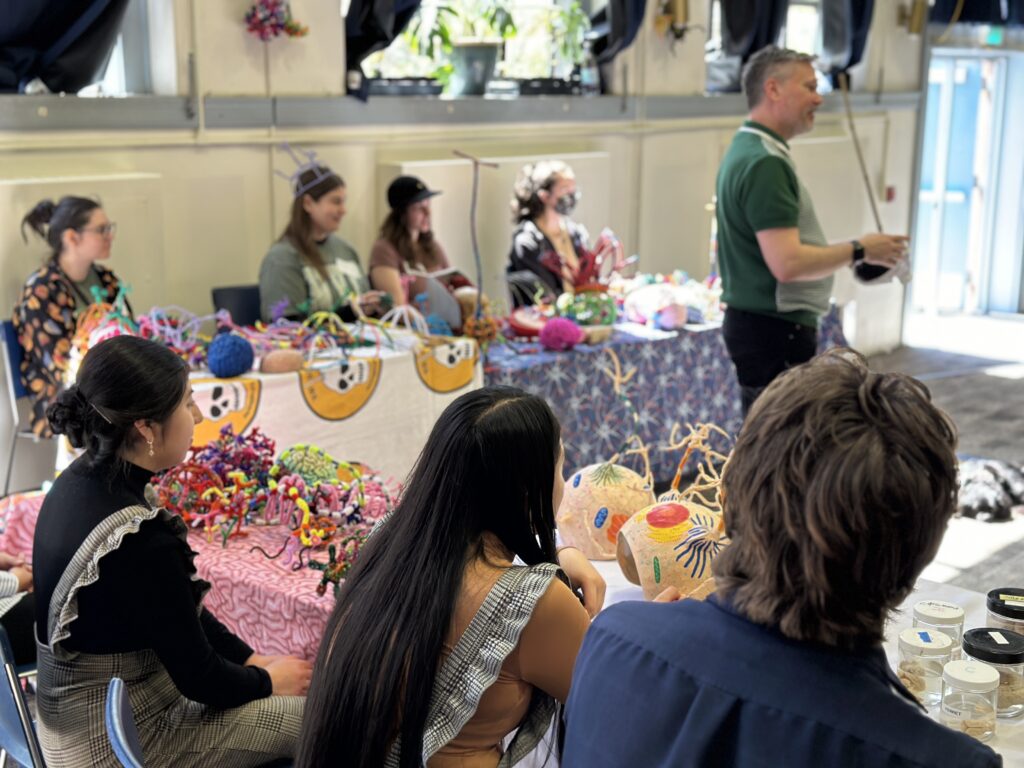
Notice the greenery on the windows!
LEARN MORE: Without my amygdala, would I get scared?
LEARN MORE: Effects of Indoor Plants on Human Functions
Andrew Huberman is a professor at Stanford University. He is well known for his podcast, the Huberman Lab, where he talks about science and research backed tools.

LEARN MORE: Huberman Lab Podcast
Sunlight exposure can help regulate serotonin and melatonin
Serotonin
Serotonin is a brain neurotransmitter and peripheral hormone that stabilizes mood.

Lack of sunlight decreases levels of serotonin, while increasing the risk of depression. Research finds that people who receive less sunlight have a higher likelihood of cognitive impairment, including the ability to think clearly, remember and make decisions.
LEARN MORE: Effect of sunlight exposure on cognitive function among depressed and non-depressed participants
LEARN MORE: Effect of sunlight and season on serotonin turnover in the brain
LEARN MORE: Association Between Sunlight Exposure and Mental Health
Serotonin carries important messages between neurons in the brain. The cell bodies of these neurons are located in the raphe nuclei in your brainstem, but the neurotransmitter is released from their axon terminals in many areas, including the prefrontal cortex.
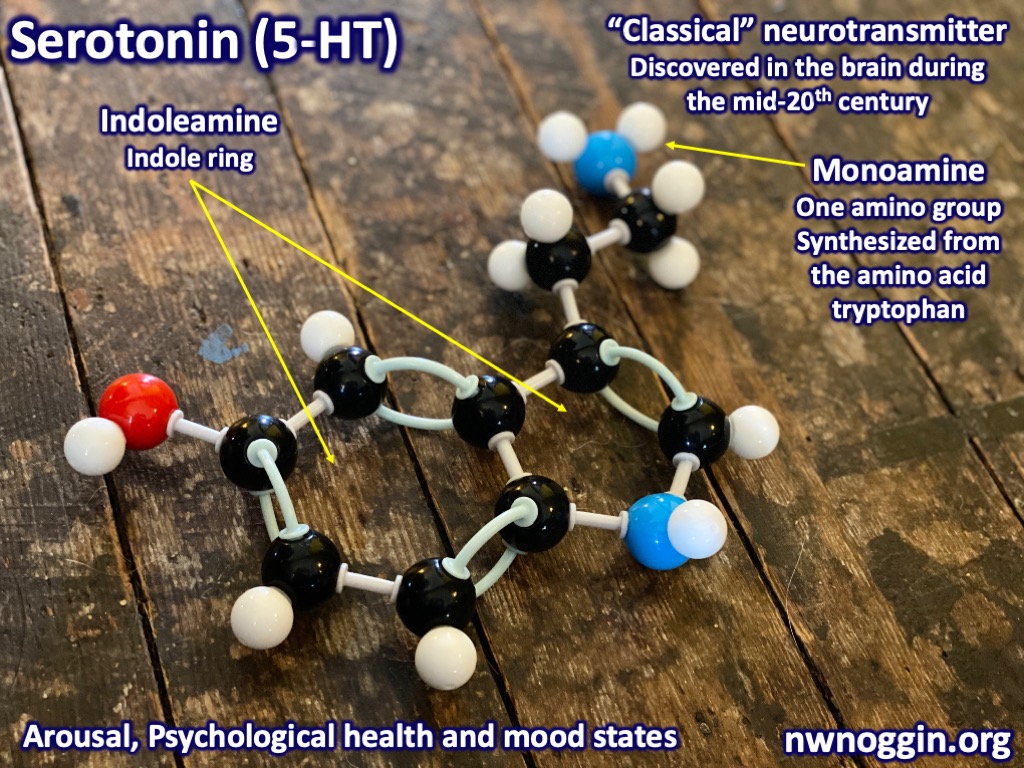
Curiously the vast majority of serotonin (about 95%!) is released outside the brain as a hormone – in your gut! I know that my gut powerfully influences how I feel. Perhaps this is why when sunlight is lacking, our entire body reacts and responds.
LEARN MORE: The Expanded Biology of Serotonin
LEARN MORE: Serotonin—Its Synthesis and Roles in the Healthy and the Critically Ill
LEARN MORE: Effect of sunlight and season on serotonin turnover in the brain
LEARN MORE: Sunshine, Serotonin, and Skin: A Partial Explanation for Seasonal Patterns in Psychopathology?
LEARN MORE: Seasonal Changes in Blood Pressure: Possible Interaction Between Sunlight and Brain Serotonin
LEARN MORE: Influence of Tryptophan and Serotonin on Mood and Cognition
LEARN MORE: How to increase serotonin in the human brain without drugs
LEARN MORE: Sunshine, Serotonin, and Skin: A Partial Explanation for Seasonal Patterns in Psychopathology?
Seasonal Affective Disorder
This is very true here in the Pacific Northwest! With limited winter sun, people can experience Seasonal Affective Disorder (or SAD), and have low mood, irritability, and a loss of interest in social activities. Light exposure has a big positive impact, reducing SAD symptoms. If you experience SAD, please go and bask in the sun (or a therapy lamp)!

LEARN MORE: What is seasonal affective disorder?
LEARN MORE: Short exposure to light treatment improves depression scores in patients with SAD
LEARN MORE: Blue-Light Therapy for Seasonal and Non-Seasonal Depression
LEARN MORE: 35 years of light treatment for mental disorders in the Netherlands
LEARN MORE: Effect of sunlight exposure on cognitive function among depressed and non-depressed participants
LEARN MORE: Using Light to Optimize Health | Huberman Lab Podcast #68
Melatonin
Low sunlight exposure also negatively impacts the regulation of melatonin.
Back in the day, humans were less advanced in terms of technology and had to depend on the sun for their daily activities. We couldn’t do much once the sun was down besides sleep, and we also spent lots of time outside in sunlight every day. However, once electricity was discovered and lighting technology advanced, we could do pretty much anything anytime. This may sound like a great thing, and in many ways it is, but it is also potentially harmful if we aren’t careful.
Blue light can make you more alert and enhance cognitive function. Again, this sounds good doesn’t it? Well, not always. Imagine trying to sleep when your brain is more alert.
Melatonin is a hormone involved in promoting sleep and has a huge impact on our sleep/wake cycle, or circadian rhythm. Melatonin is actually synthesized from serotonin and sunlight (particularly blue light) exposure prevents its release from the pineal gland on the back (or dorsal surface) of our brainstem.
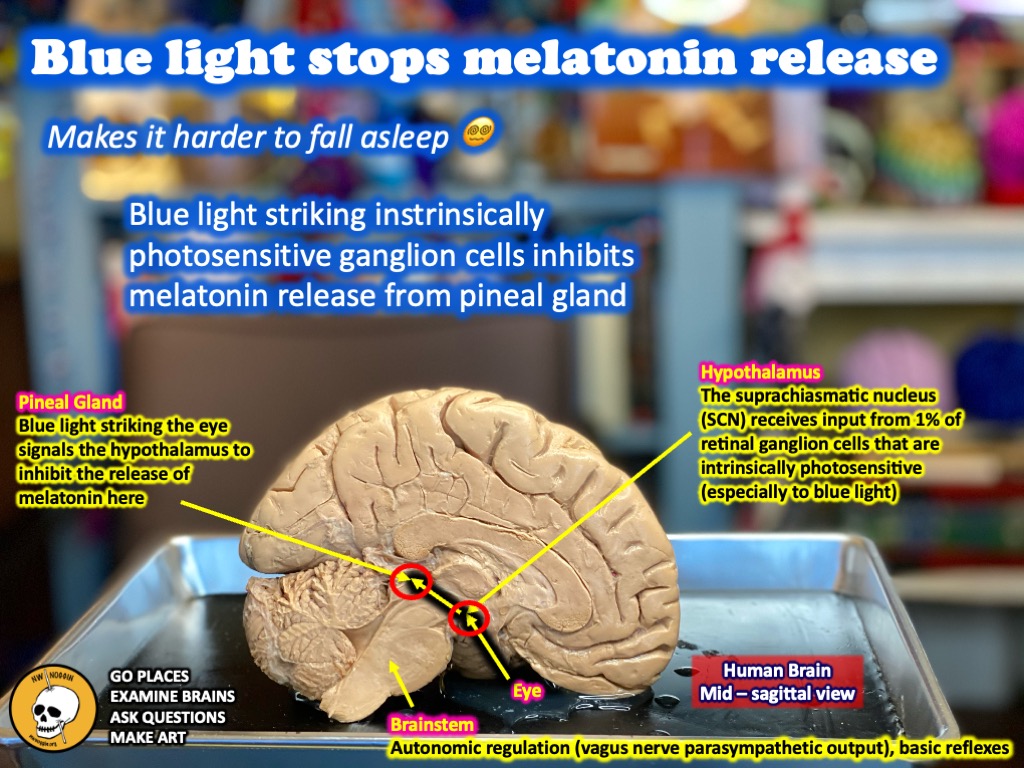
Blue light and other kinds of light at night can disrupt one’s circadian rhythm.
If there is not enough sunlight exposure in daytime, too much melatonin can be synthesized and impact our circadian rhythm. Blue light in the evening (from phones, or other screens) can also inhibit melatonin release, making it more difficult for us to go to sleep. Putting all the screens away early can help!
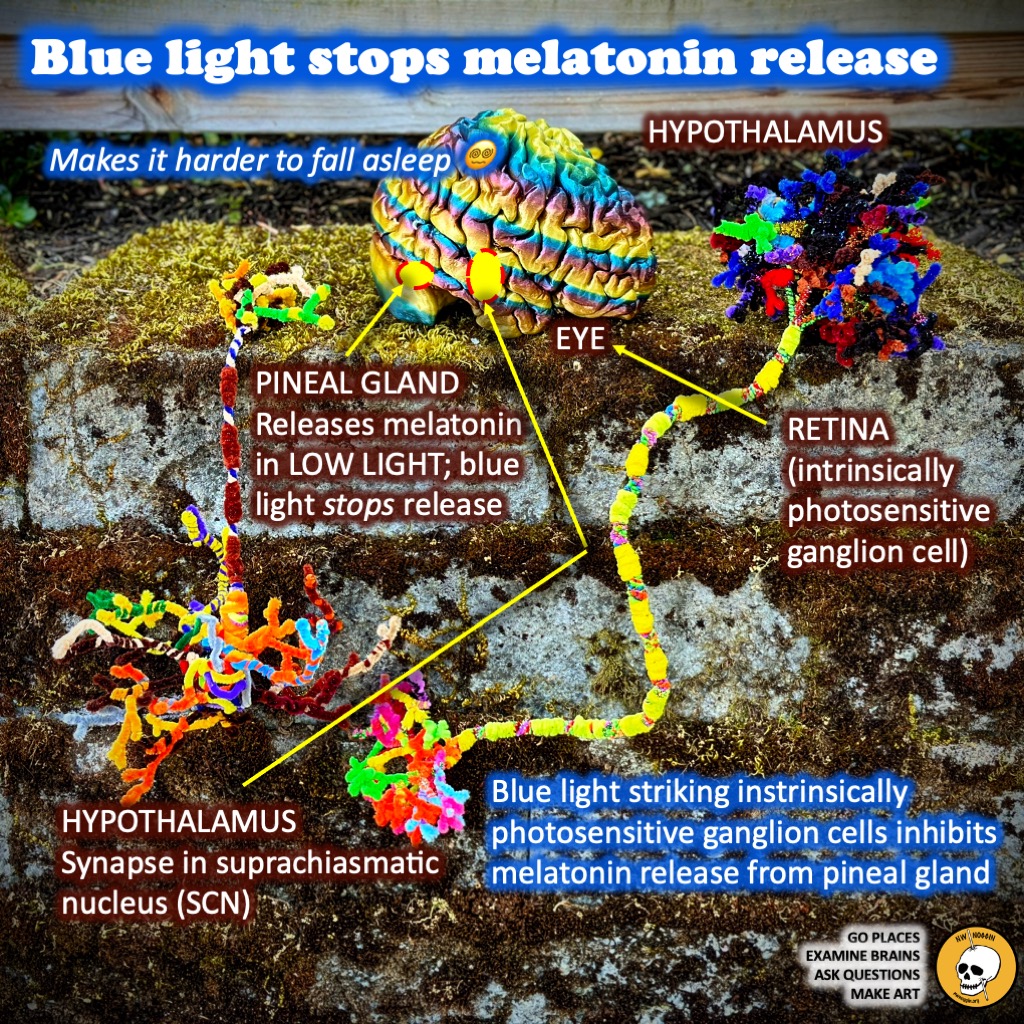
LEARN MORE: What is melatonin and how does it work?
LEARN MORE: Physiology of the Pineal Gland and Melatonin
LEARN MORE: Effects of light on human circadian rhythms, sleep and mood
LEARN MORE: Protecting the Melatonin Rhythm through Circadian Healthy Light Exposure
LEARN MORE: Effect of Light on Human Circadian Physiology
LEARN MORE: Blue light improves cognitive performance
Can too much blue light even…kill us?!
I found one study reporting that daily blue light exposure shortens lifespan and causes brain neurodegeneration in flies! The light interferes with sleep and circadian disorders. Sleep is when the brain cleans and repairs itself, so without good sleep, the brain and body can become unwell and function poorly. There is a reason why sleep deprivation is one of the worse torture methods.
LEARN MORE: Daily blue-light exposure shortens lifespan and causes brain neurodegeneration in Drosophila
LEARN MORE: Timing of light exposure affects mood and brain circuits
Light in Astoria
Below is a picture from a sunny spring day in Astoria, Oregon! Beautiful isn’t it?

We had a great time in Astoria and loved all the curious kiddos we met during outreach.

One kid asked us “where did brains come from?”…
…and we all had to stop and momentarily re-evaluate our existence.
We brought up evolution and started getting philosophical but the kid was actually asking about the real human brain specimens that we’d brought for them to see and touch in the back of the room. Phew! Did not know how I was going to answer that question at first.

LEARN MORE: Brain Cells Dance
LEARN MORE: Character Building (literally!) on the Coast
What about working nights?
Those who work night shifts are on average unhealthier than those who work in the day.
Although there are other factors that contribute, lack of sunlight is for sure one of the major ones. Sunlight helps regulate sleep and our circadian rhythms so night shifters are more sleep-deprived, and thus more vulnerable to neurological disorders including strokes, epilepsy, Alzheimer’s and Parkinson’s disease. Eating at night also alters metabolism, and decreases our ability to process blood sugar.
LEARN MORE: Shift Work Hazards
LEARN MORE: Circadian Rhythm Disruption and Subsequent Neurological Disorders in Night-Shift Workers
LEARN MORE: Consequences of Shift Work and Night Work: A Literature Review
LEARN MORE: Shift work is significantly and positively associated with dementia
LEARN MORE: Effect of night shift on development of metabolic syndrome among health care workers
LEARN MORE: Reducing the Health Risks of Night Shifts
Want to avoid worsening myopia? Get some SUN!
Myopia is a condition in which people can see things close to them clearly but objects farther away appear blurry. This happens because of the shape of our eyes; more specifically, with myopia, the eyes are elongated forwards. Nowadays, everyone is on their phones and electronic devices, especially younger generations.
Constantly looking at near objects (phones, or books) indoors, away from sunlight, actually makes our eyeballs grow longer, and the incidence of myopia is going up!
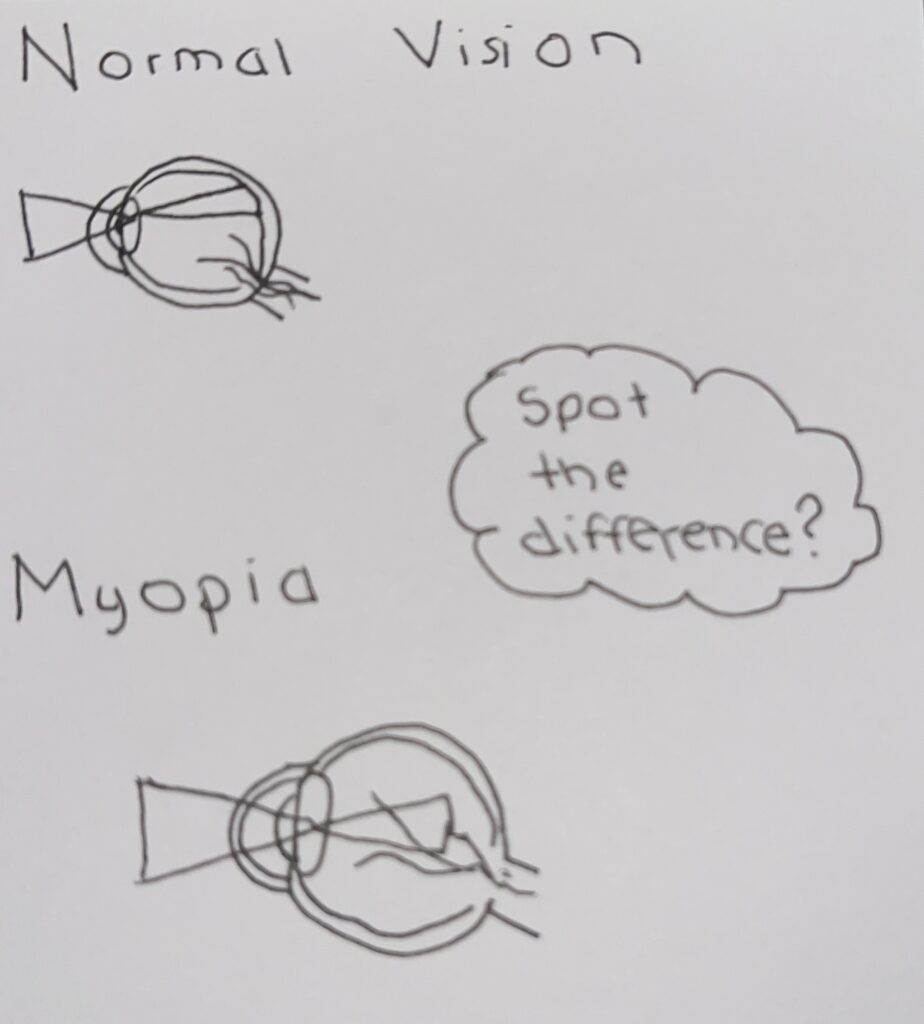
Outdoor light exposure can help prevent further elongation, with the most effective time at least two hours (preferably more) per day. Scientists think that sunlight prevents or slows eye elongation because sunlight provokes retinal dopamine release, which inhibits changes in the shape of the eye.
“…studies have found that sunlight induces dopamine release from the retina, prevents eyeball enlargement, and inhibits axial elongation. If light deprivation and low ambient illuminance inhibited the dopamine receptor in chicks, axial elongation will not be inhibited, and myopic changes will increase…”
— Ciao-Lin Ho, Wei-Fong Wu, and Yiing Mei Liou
Myopia diagnoses are increasing. Be mindful and help children keep their eyesight clear so that they don’t need to depend on glasses. Take them to the park. Or go for a hike. Or enjoy a picnic.
LEARN MORE: Dose–Response Relationship of Outdoor Exposure and Myopia Indicators
LEARN MORE: The Science of Vision, Eye Health & Seeing Better
Go outside!
Moral of the story is….go outside and get some RAW sunlight!!!
(but limit your blue light at night




